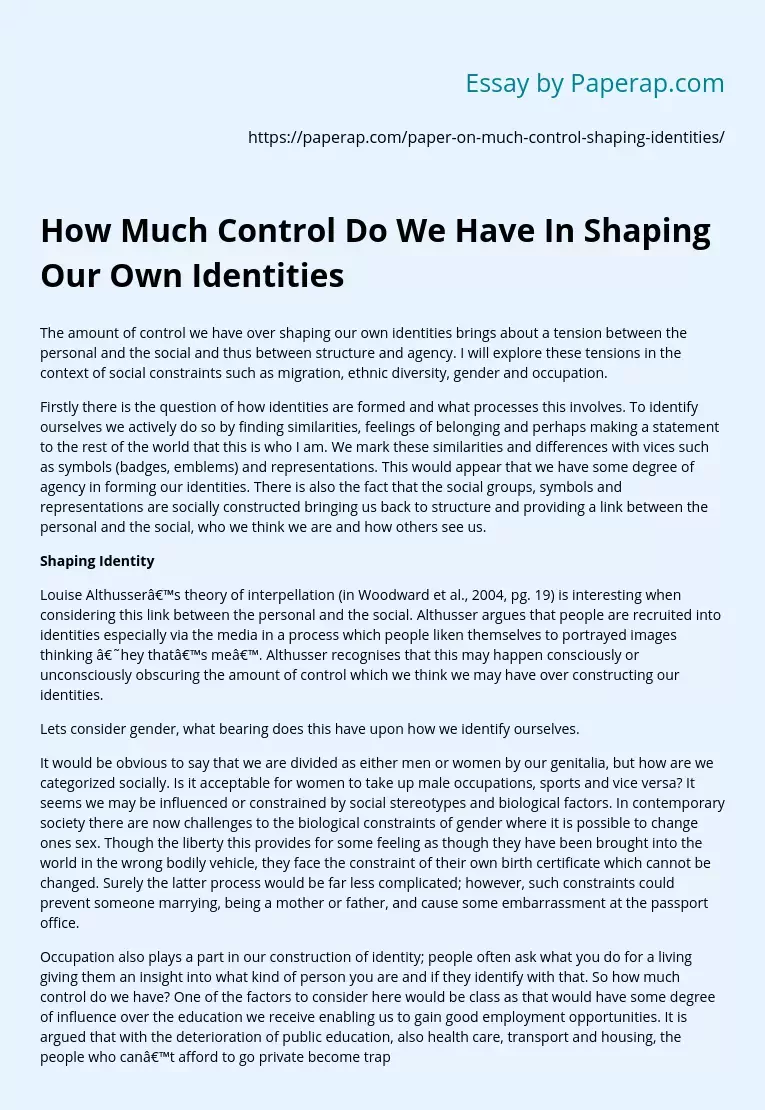How Much Control Do We Have In Shaping Our Own Identities
The amount of control we have over shaping our own identities brings about a tension between the personal and the social and thus between structure and agency. I will explore these tensions in the context of social constraints such as migration, ethnic diversity, gender and occupation.
Firstly there is the question of how identities are formed and what processes this involves. To identify ourselves we actively do so by finding similarities, feelings of belonging and perhaps making a statement to the rest of the world that this is who I am.
We mark these similarities and differences with vices such as symbols (badges, emblems) and representations. This would appear that we have some degree of agency in forming our identities. There is also the fact that the social groups, symbols and representations are socially constructed bringing us back to structure and providing a link between the personal and the social, who we think we are and how others see us.
Shaping Identity
Louise Althusser’s theory of interpellation (in Woodward et al.
, 2004, pg. 19) is interesting when considering this link between the personal and the social. Althusser argues that people are recruited into identities especially via the media in a process which people liken themselves to portrayed images thinking ‘hey that’s me’. Althusser recognises that this may happen consciously or unconsciously obscuring the amount of control which we think we may have over constructing our identities.
Lets consider gender, what bearing does this have upon how we identify ourselves.
It would be obvious to say that we are divided as either men or women by our genitalia, but how are we categorized socially.
Is it acceptable for women to take up male occupations, sports and vice versa? It seems we may be influenced or constrained by social stereotypes and biological factors. In contemporary society there are now challenges to the biological constraints of gender where it is possible to change ones sex. Though the liberty this provides for some feeling as though they have been brought into the world in the wrong bodily vehicle, they face the constraint of their own birth certificate which cannot be changed. Surely the latter process would be far less complicated; however, such constraints could prevent someone marrying, being a mother or father, and cause some embarrassment at the passport office.
Occupation also plays a part in our construction of identity; people often ask what you do for a living giving them an insight into what kind of person you are and if they identify with that. So how much control do we have? One of the factors to consider here would be class as that would have some degree of influence over the education we receive enabling us to gain good employment opportunities. It is argued that with the deterioration of public education, also health care, transport and housing, the people who can’t afford to go private become trapped in poverty (in Mackintosh and Mooney et al., 2004, pg. 109). It also appears that the collective identity of class is shifting towards a more individual identity expressed through consumption and lifestyle. The degree to which we can express ourselves in this way is heavily constrained by money, which if stuck in a poverty trap which exists through structure, there are definite limitations on agency.
The UK today is a multi ethnic society bearing constraints such as racism. Although it is not accepted to be racist, does it still exist and are there racial constraints in employment, education and housing? How we form our identities in this context is relative, again by marking similarities and differences. The experience of being black for example can only be experienced in relation to whiteness. Therefore a diversity of ethnic identities may be experienced depending upon which context you find yourself in.
Finally, how can we challenge these constraints? In relation to ethnicity there was the Black Power movement in the 60’s. Slogans such as ‘black is beautiful’ sought to make being black positive rather than less powerful in relation to being white. Also movements such as gay and lesbian rights, women’s rights etc focused on making these positive statements of identity. This challenges how these groups are seen and how we think about them. Therefore through collective action it is possible to exert some element of control in changing socially constructed concepts.
How Much Control Do We Have In Shaping Our Own Identities. (2019, Dec 05). Retrieved from https://paperap.com/paper-on-much-control-shaping-identities/

